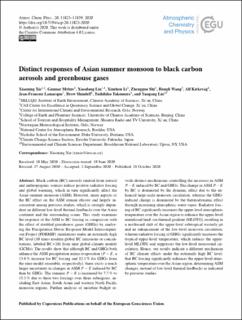| dc.contributor.author | Xie, Xiaoning | |
| dc.contributor.author | Myhre, Gunnar | |
| dc.contributor.author | Liu, Xiaodong | |
| dc.contributor.author | Li, Xinzhou | |
| dc.contributor.author | Shi, Zhengguo | |
| dc.contributor.author | Wang, Hongli | |
| dc.contributor.author | Kirkevåg, Alf | |
| dc.contributor.author | Lamarque, Jean-Francois | |
| dc.contributor.author | Shindell, Drew | |
| dc.contributor.author | Takemura, Toshihiko | |
| dc.contributor.author | Liu, Yangang | |
| dc.date.accessioned | 2021-08-13T06:55:46Z | |
| dc.date.available | 2021-08-13T06:55:46Z | |
| dc.date.created | 2021-01-25T12:47:47Z | |
| dc.date.issued | 2020 | |
| dc.identifier.citation | Atmospheric Chemistry and Physics. 2020, 20 (20), 11823-11839. | en_US |
| dc.identifier.issn | 1680-7316 | |
| dc.identifier.uri | https://hdl.handle.net/11250/2767682 | |
| dc.description.abstract | Black carbon (BC) aerosols emitted from natural and anthropogenic sources induce positive radiative forcing and global warming, which in turn significantly affect the Asian summer monsoon (ASM). However, many aspects of the BC effect on the ASM remain elusive and largely inconsistent among previous studies, which is strongly dependent on different low-level thermal feedbacks over the Asian continent and the surrounding ocean. This study examines the response of the ASM to BC forcing in comparison with the effect of doubled greenhouse gases (GHGs) by analyzing the Precipitation Driver Response Model Intercomparison Project (PDRMIP) simulations under an extremely high BC level (10 times modern global BC emissions or concentrations, labeled BC×10) from nine global climate models (GCMs). The results show that although BC and GHGs both enhance the ASM precipitation minus evaporation (P−E; a 13.6 % increase for BC forcing and 12.1 % for GHGs from the nine-model ensemble, respectively), there exists a much larger uncertainty in changes in ASM P−E induced by BC than by GHGs. The summer P−E is increased by 7.7 % to 15.3 % due to these two forcings over three subregions, including East Asian, South Asian and western North Pacific monsoon regions. Further analysis of moisture budget reveals distinct mechanisms controlling the increases in ASM P−E induced by BC and GHGs. The change in ASM P−E by BC is dominated by the dynamic effect due to the enhanced large-scale monsoon circulation, whereas the GHG-induced change is dominated by the thermodynamic effect through increasing atmospheric water vapor. Radiative forcing of BC significantly increases the upper-level atmospheric temperature over the Asian region to enhance the upper-level meridional land–sea thermal gradient (MLOTG), resulting in a northward shift of the upper-level subtropical westerly jet and an enhancement of the low-level monsoon circulation, whereas radiative forcing of GHGs significantly increases the tropical upper-level temperature, which reduces the upper-level MLOTG and suppresses the low-level monsoonal circulation. Hence, our results indicate a different mechanism of BC climate effects under the extremely high BC level: that BC forcing significantly enhances the upper-level atmospheric temperature over the Asian region, determining ASM changes, instead of low-level thermal feedbacks as indicated by previous studies. | en_US |
| dc.language.iso | eng | en_US |
| dc.publisher | Copernicus publications | en_US |
| dc.rights | Navngivelse 4.0 Internasjonal | * |
| dc.rights.uri | http://creativecommons.org/licenses/by/4.0/deed.no | * |
| dc.title | Distinct responses of Asian summer monsoon to black carbon aerosols and greenhouse gases | en_US |
| dc.type | Journal article | en_US |
| dc.type | Peer reviewed | en_US |
| dc.description.version | publishedVersion | en_US |
| dc.source.pagenumber | 11823-11839 | en_US |
| dc.source.volume | 20 | en_US |
| dc.source.journal | Atmospheric Chemistry and Physics | en_US |
| dc.source.issue | 20 | en_US |
| dc.identifier.doi | 10.5194/acp-20-11823-2020 | |
| dc.identifier.cristin | 1878371 | |
| dc.relation.project | Notur/NorStore: NN2345K, NS2345K | en_US |
| dc.relation.project | Norges forskningsråd: 229771 | en_US |
| dc.relation.project | Norges forskningsråd: 270061 | en_US |
| dc.relation.project | Norges forskningsråd: 295046 | en_US |
| cristin.ispublished | true | |
| cristin.fulltext | original | |
| cristin.qualitycode | 2 | |

